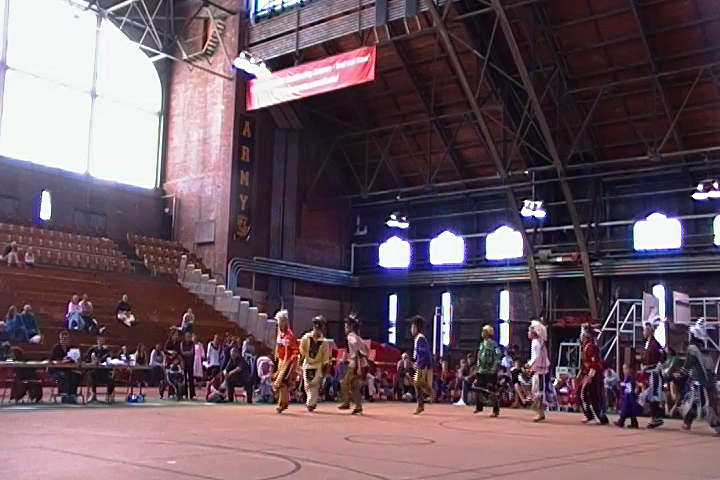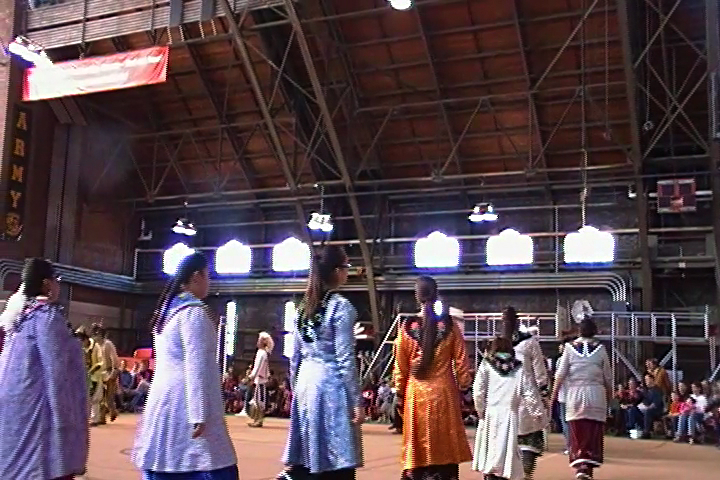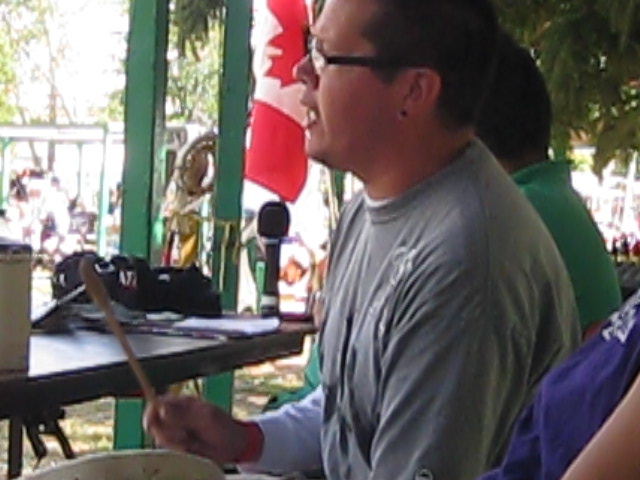Colonization's Chain: Tracing the Links That Bond Communities Through the Delaware Skin Dance
In this paper I propose that Haudenosaunee performance of the Delaware Skin Dance can be interpreted as a symbolic representation of their relationship with Delaware refugees and the conditions under which the Six Nations took them under wing. To support this idea, I focus on three primary concepts that serve as layers in unfolding this multidimensional problem: (1) that our understanding of the Delaware Skin Dance is benefited by comparing the manner in which the Haudenosaunee foster the dance with their historical treatment of Delaware people; (2) that our understanding of this music is enriched by exploring the intermediary position employed by the Haudenosaunee between the Delaware and whites; and (3) that performance of the Delaware Skin Dance reestablishes balance in Haudenosaunee-Delaware relations in accord with the arrangement by which they were integrated into Iroquois society. I link the phenomena of the Delaware Skin Dance’s transmission to colonization, which led to the decimation of Delaware population and culture, displacement, forced relocation, and assimilation.
Previous academic study of the Delaware Skin Dance is limited. My work is spurred by this gap in the literature. A description of the dance is found in just one source—the liner notes for the record Iroquois Social Dance Songs, produced by Iroqrafts in Ohsweken, Ontario in 1969 (Iroqrafts 1969). Gertrude P. Kurath’s Iroquois Music and Dance: Ceremonial Arts of Two Seneca Longhouses contains the sole transcription of a Delaware Skin Dance song; however, it lacks the ethnomusicological analysis she provides Haudenosaunee music (Kurath 1964:255). My research incorporates the perspectives of Haudenosaunee singers, dancers, and elders gathered through fieldwork interviews with ethnomusicological and historical sources. In this paper I also draw on observations made over several years as a participant observer at Iroquois social dances.
Since their first encounters with Europeans, history of the Delaware people has been a narrative of displacement and dispersal, the result of which has had devastating effects on their population and culture—particularly language and music. Today the Delaware people are spread from the Northeastern states to Oklahoma, Wisconsin, and Ontario. Recognized as “grandfathers” by nearly forty tribes, their Eastern Woodland homelands stretched throughout portions of present day New York, New Jersey, Pennsylvania, and Delaware (Heckewelder 1876:xli). The name Delaware comes from the river of the same designation, named for Sir Thomas West, Baron de la Warr, second governor of the Virginia colony (Sturtevant and Trigger 1978:213, 235). It refers to culturally similar Algonquian people living in communities in and around the Delaware River Valley at the beginning of the seventeenth century who shared loose political affiliation. They spoke closely related Algonquian dialects: Unami, Munsee, and Unalachtigo. The name “Delaware” is often synonymously linked with the name “Lenape,” although not all people that came to be referred to as Delaware were Lenape.1 I use the name Delaware in this paper because it is the name used by the Haudenosaunee and fittingly describes the heterogeneous refugee population of whom I speak.
The Delaware were one of the first tribes to have contact with Europeans. They received the brunt of colonization as newcomers settled the coast, scattering their population and pushing them increasingly westward. While the main body of Delaware people was relocated to Indian Territory, refugee groups remained peppered throughout the Northeast. Some of these bands sought refuge with their northern neighbors, the Haudenosaunee. The name “Haudenosaunee” means “People of the Longhouse.” The Haudenosaunee are also called the Iroquois, the Six Nations, and were referred to as Mengwe by the Delaware (Heckewelder 1876:xxiv). A confederacy originally comprised of five nations—the Seneca, Cayuga, Onondaga, Oneida, Mohawk, and later a sixth, the Tuscarora—took in Delaware refugees before and after the American Revolution. In the 1740s many Delaware were forced by land cessions to move to Six Nations’ territories while some Northern Unami Delaware, Munsee Delaware, and Nanticokes became tribal “satellites” of the Six Nations (Sturtevant and Trigger 1978:222–223). Following the American Revolution, some of these remnant people went to live with the Haudenosaunee. While these removals are too extensive to fully detail here, a couple of examples include a band of Munsee who traveled up the Allegheny to live with the Seneca in 1791 and Delaware refugees who moved to live with the Iroquois on Grand River—now the Six Nations Reserve—in Ontario, Canada (Sturtevant and Trigger 1978:222; Speck 1927:22; Diamond, Cronk and Von Rosen 1994:187). While many Delaware remained at Six Nations, in some cases these populations moved on. For example, a portion of the Delaware population at Six Nations later moved from Grand River to live among the Chippewa of the Thames. Today these Delaware are known as the Munsee-Delaware Nation (Munsee-Delaware Nation 2005).
Harboring the Delaware provided an opportunity for cultural exchange, from which one relic remains prominently displayed in Haudenosaunee culture—the Delaware Skin Dance. Younger people commonly refer to the dance by the name “Stick Dance” because of the way it is accompanied today, but Haudenosaunee elders interviewed by the author insist that the dance’s proper name is the “Delaware Skin Dance,” a name that also derives from the manner in which it was accompanied. The Delaware Skin Dance was once accompanied on a version of the Delaware skin drum, the ceremonial instrument used by Delaware singers in the Big House ceremony. The Delaware skin drum is an idiophone made of folded dried deerskin that is struck with wooden beaters (Harrington 1921:249). Although one longhouse still keeps a dried hide on which they beat when the Delaware Skin Dance is performed there, Haudenosaunee singers do not use the traditional skin drum in their performances at festivals, social dances, and other public events. Instead, they imitate the drum’s sharp, percussive sound by using a wooden drumstick to keep time on a hard surface, like a wooden bench or chair. Delaware Skin Dance songs are particularly significant in the study of Delaware music because they are one of the largest and oldest bodies of living Delaware music. While some contemporary Delaware have heard the songs at Haudenosaunee social dances, they do not know them.
The Delaware Skin Dance holds an important place in Haudenosaunee social dance repertoire and is danced in communities throughout New York state and Ontario.

Figure 1: Men dancing the Delaware Skin Dance at the 2010 Cornell University Smoke Dance Competition. Barton Hall, Ithaca, New York.
Dancers line up single file, women behind men, and are accompanied by a set of short, sharply rhythmical songs that average between ½ and 1 minute in duration.

Figure 2: Women dancing the Delaware Skin Dance in line behind the men at the 2010 Cornell University Smoke Dance Competition. Barton Hall, Ithaca, New York.
Songs are sung consecutively with short periods of rest for the dancers during transitions between songs. The dance can last upwards of twenty minutes. There are several dozen Delaware Skin Dance songs, although specific song repertoire varies from singer to singer as do the songs presented at any given performance.
Audio 1: Wesley Halsey (Oneida, Wolf Clan) singing the Delaware Skin Dance at the First People’s Festival in Ithaca, New York, October 2, 2010. The two songs are separated by a section in free meter with call and response.
As Delaware people were integrated into Haudenosaunee communities the Delaware Skin Dance moved from their custody into a new space where it became attached to the Iroquois through its regular performance at social dances. Over time the dance was dislocated so far from its origins that it became a remote relic. I believe the paths of Delaware refugees and their music diverged as a result of the Haudenosaunee’s systematic arrangement and protocol for receiving foreign nations that encourages them to accept Iroquois culture in place of their own. This viewpoint is described in the Great Law of Peace, also known as the Great Binding Law or Constitution of the Six Nations Confederacy, that was developed by the Great Peacemaker, Deganawida, and his spokesman Hiawatha. It describes the concessions expected from those adopted:
When the adoption of anyone shall have been confirmed by the chiefs of the Nation the chiefs shall address the people of the Nation and say: ‘Now you of our nation, be informed that . . . (such a person, such a family, or such families) have ceased forever to bear their birth nation’s name and have buried it in the depth of the earth. Henceforth let no one of our nation ever mention the original name or nation of their birth. To do so will hasten the end of our peace. (The Great Law of Peace of the Longhouse People; Kaianerekowa Hotinonsionne 1971:70)
As foreign people, the Delaware were denied a vote in the Council of the chiefs of the League, although an official member could represent them. The Cayuga became representatives of the Delaware they adopted in 1763 (The Great Law of Peace of the Longhouse People; Kaianerekowa Hotinonsionne 1971:76–77; Miller 1974:510). Not allowing outsiders to serve on Council helped safeguard against change within the confederacy that might threaten long-held Haudenosaunee ideals. The Great Law of Peace promotes stability, continuity, and provides means to systematically reduce outside influences. Integration of Delaware music was regulated differently than assimilation of Delaware people, although their commonality lies in the fact that they were both incorporated in ways that promoted consistency.
While some Delaware people eventually moved on after staying with the Haudenosaunee, others remained in Iroquoia, marrying into Iroquois families. It is difficult to pinpoint exactly when their identity shift from Delaware to Haudenosaunee was complete. In certain communities—especially where the Delaware were small in number—this probably happened early on. Munsee who settled among the Seneca, however, kept their cultural identity through the nineteenth century and Delaware at Six Nations Reserve retained their language and music into the early twentieth century (Sturtevant and Trigger 1978:222). Today, Delaware families at Six Nations Reserve still recognize their Delaware ancestry. A description of the Delaware Skin Dance at Six Nations Reserve in the Iroqrafts album liner notes helps us imagine how the Haudenosaunee learned the dance.
This dance came to the Iroquois when the few score Ohsweken Delaware abandoned their traditions. This was a relatively recent loss as Iroquois men in their 70’s recall dancing in their youth “over on Delaware line” (a Reserve road along which the Delaware had clustered) with singing from old Delaware men. . . . Some older people maintain these recorded songs came from the Allegany Seneca who danced this more than the . . . [Ohsweken people] used to. (Iroqrafts 1969)
Munsee and Unami Delaware have stark linguistic differences from Six Nations’ languages. In fact, according to Grumet (2009:9), Iroquoian languages are as different from Algonquian languages as Japanese is from English. Yet, Haudenosaunee and Delaware song and dance styles possess prominent similarities in melody, rhythm, and form. In his discussion of Mohican music, David McAllester suggests there is evidence of a “general Eastern Woodlands musical style,” based on the similarity in form found in music from that area. Specifically, he calls attention to prevalence of a bipartite structure, which consists of a section in rhythmically free meter followed by a section with a steady beat (McAllester 2005:100). The Delaware Skin Dance, and the Haudenosaunee social dance songs it is performed after, possess bipartite structure. Melodic, rhythmic, and structural similarities between Delaware and Haudenosaunee music help explain the ease with which the Delaware Skin Dance was integrated into the complex of Haudenosaunee social dance music.2 In a review of the Iroqrafts album, Gertrude Kurath wrote, “The secular dances of exotic origin are significant, for they demonstrate the Iroquois manner of accepting outside influences into their rich and already composite repertoire…The Delaware Skin Dance on Record 1 is an oddball cycle. An obsolescent vestige from Delaware refugees, it apparently is regaining favor” (Kurath 1970:189–190).
Having looked at how the Delaware and their music were assimilated into Iroquois society and social dance practice, I now move further back in time to explore Delaware displacement and relocation in Iroquoia. The root of tensions between the Haudenosaunee and Delaware has been a topic of contestation since colonial writings. A popular focus has been the way the Iroquois “made women” of the Delaware, and whether this was accomplished through Iroquois victory or by consent from the Delaware. This topic has been written about for centuries by authors ranging from Moravians to contemporary scholars, including David Zeisberger (1771), George Loskiel (1794), Lewis Henry Morgan (1851), John (Heckewelder (1876), C. A. Weslager (1944), Anthony Wallace (1944, 1947), and Frank Speck (1946), to name a few who contributed to foundations of the conversation. According to Heckewelder, the Delaware became women by consent, probably sometime between 1609 and 1620 at “Nordman’s Kill” near present day Albany (Heckewelder 1876:xxviii). Speck describes one version of the occasion by citing Moravian historian Loskiel, one of the first to write on the subject.
The Delaware, so their story went, accepted this respected position as matrons. During a ceremony that marked the occasion, the Iroquois, according to the Delaware version, are supposed to have said: "We dress you in a woman's long habit reaching down to your feet and adorn you with ear rings," meaning that they should not take up arms again. "We hang a calabash filled with oil and medicine on your arms," meaning that they should use the oil to clean the ears of those who could not distinguish good from evil, and also use the medicine to heal those walking in evil. "We deliver unto your hands a plant of Indian corn and a hoe," meaning that they should thereafter be as women. Later the Delaware claimed that they had been duped, their independence forfeited, their autonomy humiliated. After accepting the pact in good faith, they said that they found they had sacrificed their individual rights and the Five Nations were exploiting them and that they were helpless to retaliate, having obligated themselves by their sacred word of honor which could not be broken. (Speck 1946:378)
In becoming women the Delaware laid down arms and worked to preserve peace between tribes; they also relinquished their ability to make land negotiations, which placed the Iroquois in an intermediary position between them and Euro-Americans. Feminization was seen as a derogatory designation in the eyes of whites, but I argue that this sentiment was not possessed in traditional American Indian culture. Both the Delaware and the Haudenosaunee held women in the highest esteem in their matrilineal societies. I interpret “making women” of the Delaware to signify a transformation of social and political arrangement. However, colonists’ recognition of the Haudenosaunee as “men” provided them the opportunity to make dealings on behalf of the Delaware; this did not sit well with some Delaware people. Heckewelder relays the opinion of his Delaware acquaintances that felt subjugated by the Iroquois, who told him, “They would sell the lands of other nations to the English and receive the money, pretending to a paramount right to the whole territory, and this, say the Lenape, was their manner of CONQUERING NATIONS!” (Heckewelder 1876:70). In 1736 the Haudenosaunee sold Munsee and Unami Delaware land between the Delaware and Susquehanna rivers below the Kittatiny Ridge (Grumet 2009:xxviii). In 1742 they directed the Munsee to leave their lands claimed by the Walking Purchase and move to the Susquehanna River Valley. By 1754, during the Albany Congress, Haudenosaunee chiefs had sold nearly all Native lands in Pennsylvania (Grumet 2009:xxix). Although they subsequently declared the Delaware “men” again at the Treaty of Greenville, Ohio in 1795, the designation of “women” persisted and continued to influence their treatment of the Delaware (Heckewelder 1876:xxxix; Miller 1974:509–510).
The Great Law of Peace discusses development of a symbolic relationship between the Iroquois and conquered nations brought into their communities. It instructs:
Whenever a foreign nation is conquered and the survivors are brought into the territory of the League of Five Nations and placed under the Great Peace, the two shall be known as the Conqueror and the Conquered. A symbolic relationship shall be devised, and be placed in some symbolic position. (The Great Law of Peace of the Longhouse People; Kaianerekowa Hotinonsionne 1971:86)
Performance of the Delaware Skin Dance can be perceived as one kind of representation of the symbolic relationship between the Delaware and Haudenosaunee, which leads to my final point: performance of the dance reestablishes balance in Haudenosaunee-Delaware relations in accord with the arrangement by which they were integrated into Haudenosaunee communities as a tributary, dependent nation who were persuaded to give up their culture and take on that of the Iroquois. Performance of the Delaware Skin Dance restates this relationship while simultaneously honoring the dance’s former ceremonial function. The Haudenosaunee strive to maintain continuity in music native to their musical tradition as well as foreign music, like the Delaware Skin Dance. This endeavor corresponds with ethics in the Great Law of Peace that encourage that “the rites and festivals of each nation shall remain undisturbed and shall continue as before, because they were given by the people of old times as useful and necessary for the good of men” (The Great Law of Peace of the Longhouse People; Kaianerekowa Hotinonsionne 1971:99).
Haudenosaunee oral history describes how the Delaware Skin Dance became part of their repertoire and what the dance means to them. They say the Delaware entrusted them with safekeeping the dance when their culture was suffering and they did not have singers that could continue to sing and teach it. The Delaware asked the Iroquois to keep the songs until the time came when they could sing them again (Shenandoah 2008). Haudenosaunee singers, who possess an extensive song repertoire, still undertake the preservation, practice, and continuance of the Delaware Skin Dance.

Figure 3: Oneida singer Lotunt Honyust sharing the Delaware Skin Dance with Delaware people at the Delaware Nation Powwow. Moraviantown, Ontario, September 2011.
As a sign of respect, the Delaware Skin Dance is often danced at the end of the social dance and people are sometimes asked to remove their hats (Galban 2008). Some singers believe that its performance is meant to honor the Delaware and that its transmission to the Haudenosaunee was part of a larger adoption arrangement where the Delaware agreed to relinquish their Delaware identity and the Seneca agreed to perform the dance in a place of honor. Others say they perform the Delaware Skin Dance last to show respect for it because it was a ceremonial dance. It is also performed last because it is a favorite dance and its fast tempo makes it an ideal candidate to top off the night. “It’s not protocol for the Delaware Skin Dance to be performed last,” says Vicki Shenandoah, a Wolf Clan Oneida, “but this dance is often saved for last. It’s a fun dance” (Shenandoah 2008).
In this paper I explored embodiment of Haudenosaunee-Delaware refugee relations in preservation and performance of the Delaware Skin Dance. I interpreted the dance’s performance as a symbolic representation of roles they assumed. The Haudenosaunee fostering of the Delaware Skin Dance is compared with their custody of the Delaware. I explored events that led to Delaware relocation, highlighting the intermediary role employed by the Haudenosaunee in eighteenth century colonist negotiations. I conclude by suggesting that performance of the Delaware Skin Dance metaphorically restores equilibrium in Haudenosaunee-Delaware refugee relations and provides a forum for remembrance of their shared history.
The Delaware Skin Dance is one of many examples where colonization significantly influenced American Indian musical traditions. Analysis of the Delaware Skin Dance must be informed with recognition of Delaware displacement. Understanding the complex histories of displaced populations is challenging; yet more reason why they deserve academic study by ethnomusicologists who can contribute a valuable perspective in the development of collective narratives of these unique histories. Those who see the potential of music to aurally connect us with an underrepresented time and people of the past recognize the special significance of music that survives displacement. Contemplating this may lead us to wonder: “When we close our eyes and listen to the Delaware Skin Dance, is the sound reminiscent of what Delaware ancestors heard long ago in the woodlands of the Northeast?” If so, can the dance also reflect the many roads traveled by its bearers between its origins and the present, thereby providing a window through which we might learn more about them? The disastrous repercussions of colonization reverberate in the displacement of the Delaware people and their music, but their story lives on through Haudenosaunee performance of the Delaware Skin Dance.
References
Anonymous. 1971. The Great Law of Peace of the Longhouse People; Kaianerekowa Hotinonsionne. League of Six Nations. Rooseveltown, NY: White Roots of Peace, Mohawk Nation at Akwesasne.
Diamond, Beverley. 2008. Native American Music in Eastern North America: Experiencing Music, Expressing Culture. New York: Oxford University Press.
––––––, M. Sam Cronk, and Franziska Von Rosen. 1994. Visions of Sound: Musical Instruments of First Nations Communities in Northeastern America. Chicago: University of Chicago Press.
Galban, Michael. 2008. Telephone interview with author. 15 March 2008.
Grumet, Robert Steven. 2001. Voices from the Delaware Big House Ceremony. Norman: University of Oklahoma Press.
––––––. 2009. The Munsee Indians: A History. Norman: University of Oklahoma Press.
Harrington, M. R. 1921. Religion and Ceremonies of the Lenape. New York: AMS Press.
Heckewelder, John Gottlieb Ernestus. 1991 [1876]. Account of the History, Manners, and Customs of the Indian; History, Manners, and Customs of the Indian Nations Who Once Inhabited Pennsylvania and the Neighboring States. Salem, NH: Ayer.
Iroqrafts. 1969. Iroquois Social Dance Songs. Ohsweken: Iroqrafts.
Kurath, Gertrude Prokosch. 1964. Iroquois Music and Dance: Ceremonial Arts of Two Seneca Longhouses. Washington, DC: Superintendent of Documents, U.S. Government Printing Office.
Loskiel, George Henry. 1794. History of the Mission of the United Brethren Among the Indians in North America. London: Brethren's Society for the Furtherance of the Gospel.
McAllester, David P. 2005 “Mohican Music, Past and Present.” In Mohican Seminar 2: The Challenge, An Algonquian Peoples Seminar, edited by Shirley W. Dunn. Albany, NY: State University of New York.
Miller, Jay. 1974. “The Delaware as Women: A Symbolic Solution.” American Ethnologist 1(3):507–14.
Morgan, Lewis Henry. 1962 [1851]. League of the Iroquois. Secaucus, NJ.: Citadel Press.
Munsee-Delaware Nation. 2005. Chiefs of Ontario. In Chiefs of Ontario [online database]. Available from http://www.chiefs-of-ontario.org/profiles/pr_munseedelaware.html.
Shenandoah, Vicki. 2008. Telephone interview with author. 18 March 2008.
Speck, Frank G. 1927. The Nanticoke and Conoy Indians: With a Review of Linguistic Material from Manuscript and Living Sources: An Historical Study. Wilmington: Historical Society of Delaware.
––––––. 1946. "The Delaware Indians as Women: Were the Original Pennsylvanians Politically Emasculated?" The Pennsylvania Magazine of History and Biography 70(4):377–89.
Sturtevant, William C., and Bruce G. Trigger. 1978. Handbook of North American Indians. Vol. 15, Northeast. Washington, DC: Smithsonian.
Wallace, Anthony F. C. 1949. King of the Delawares: Teedyuscung, 1700–1763. Philadelphia: University of Pennsylvania Press.
Weslager, C. A. 1944. "The Delaware Indians as Women." Journal of the Washington Academy of Sciences 34(12):381–388.
––––––. 1947. Further Light on the Delaware Indians as Women. Washington, DC: Washington Academy of Sciences.
Zeisberger, David, Hermann Wellenreuther, and Carola Wessel. 2005. The Moravian Mission Diaries of David Zeisberger, 1771–1781. University Park: Pennsylvania State University Press.
- 1. In Munsee Delaware, Lunaapeew (Lenape) means an Indian or a Delaware Indian.
- 2. The Delaware Skin Dance is not the only dance that has been adopted into Haudenosaunee repertoire. Others include the Alligator Dance from the Seminole of Florida, the Round Dance brought north from Oklahoma, and the Shake the Bush Dance from the Tutelo.




